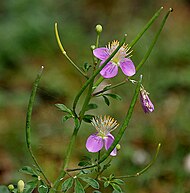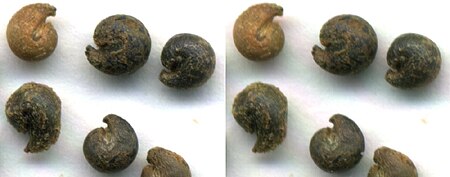Cleome
From Wikipedia, the free encyclopedia
| Cleome | |
|---|---|
 | |
| Cleome hassleriana in Kerala, India | |
| Scientific classification | |
| Kingdom: | Plantae |
| (unranked): | Angiosperms |
| (unranked): | Eudicots |
| (unranked): | Rosids |
| Order: | Brassicales |
| Family: | Cleomaceae |
| Genus: | Cleome L. |
| Species | |
See text
| |
| Stereo image | ||
| ||
| ||
| ||
| ||
| Cleome seeds resemble snail shells |
Cleome is a genus of flowering plants in the family Cleomaceae. Previously it had been placed in the family Capparaceae, until DNA studies found the Cleomaceae genera to be more closely related to the Brassicaceae than the Capparaceae. The APG II system[1] allows for Cleome and the other members of the Cleomaceae to be included in the Brassicaceae.
The genus sensu stricto includes about 170 species of herbaceous annual or perennial plants and shrubs.[2] The genus has a subcosmopolitan distribution throughout the tropical and warm temperate regions of the world.[2]However, a recent DNA study failed to separate Cleome, Podandrogyne, and Polanisia from each other, so some taxonomists have abandoned the last two of these genera, treating them as part of Cleome sensu lato; in this case, Cleome contains about 275 species, the vast majority of the Cleomaceae.
As a genus, it contains species which show a developmental progression from C3 photosynthesis to C4 photosynthesis. This, combined with its being very close to Brassicaceae (and therefore closely related to the model plant species Arabidopsis thaliana), make it an ideal genus in which to study how C4 photosynthesis occurs and how it evolved. Morphological differences that demonstrate the transition from C3 to C4 include C3 species having more veins and larger bundle sheath cells. Also, proteins present in species such as Cleome gynandra are needed for C4 photosynthesis.[3]
Species of Cleome are commonly known as spider flowers, spider plants, spider weeds, or bee plants.[4][5]






ليست هناك تعليقات:
إرسال تعليق